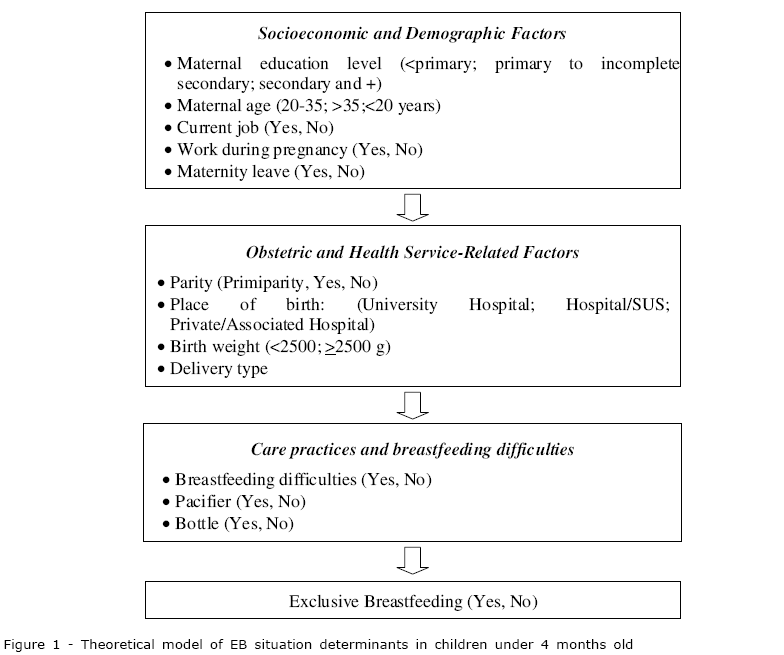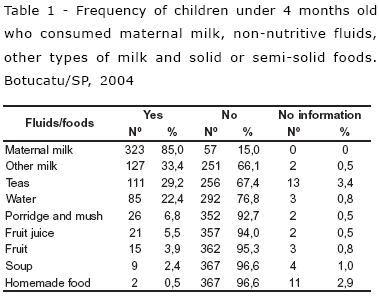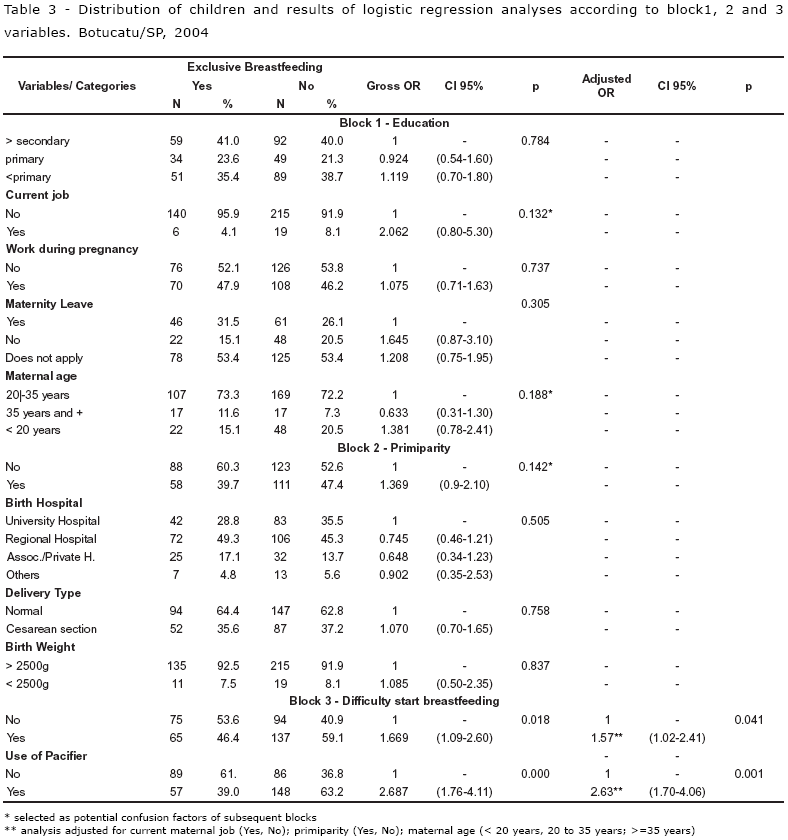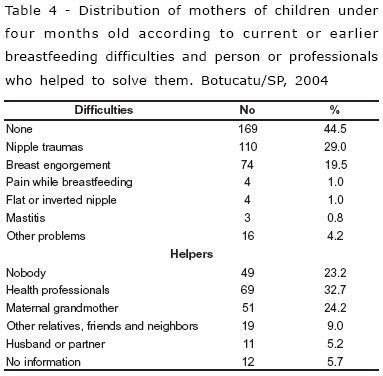Abstracts
This study aimed to identify factors associated with exclusive breastfeeding (AME) and the reasons mothers presented to introduce complementary feeding in the first four months of life. A total of 380 mothers (92.2%) of children under four months old vaccinated in a Multi-vaccination Campaign were interviewed. To identify factors associated to AME, univariate and multiple logistic regressions analyses were performed. Thirty-eight percent of the children were on AME; 33.4% consumed cow milk; 29.2% tea; and 22.4% water. The mothers justified introduction of cow milk by factors related to quantity/quality of maternal milk and "necessity" of the child. The use of a pacifier (odds ratio=2.63; CI95%=1.7-4.06) and difficulty to breastfeed (odds ratio=1.57; CI95%=1.02-2.41) were associated with the absence of AME. The populational attributable risk percentage for the use of a pacifier was estimated at 46.8 %. Thus, modifiable risk factors were associated with AME interruption.
breast feeding; human milk; weaning; risk factors
El objetivo fue identificar factores asociados a la lactancia materna exclusiva (AME) y los motivos presentados por las madres para la introducción de alimentos complementares en los primeros 4 meses de vida. Se les entrevistaron a 380 madres (92,2%) de niños menores de 4 meses vacunados en una Campaña de Multivacunación. Para identificación de los factores asociados a la situación del niño con relación al AME, se realizaron análisis de regresión logísticas univariadas y múltiplas. En AME estaba el 38,0% de los niños; el 33,4% consumía leche de vaca; el 29,2% té y el 22,4% agua. Las madres justificaron la introducción de leche de vaca por factores relativos con la cantidad/calidad de la leche materna y "necesidad" del niño. El uso de chupete (odds ratio=2,63; IC95%=1,7-4,06) y relato de dificultad con la lactancia (odds ratio=1,57; IC95%=1,02-2,41) se asociaron a la ausencia de AME. El riesgo atribuible poblacional asociado al uso de chupete fue 46,8%. Así, factores modificables fueron identificados como de riesgo para interrupción de AME.
lactancia materna; leche humana; destete; factores de riesgo
Objetivou-se identificar fatores associados ao aleitamento materno exclusivo (AME) e os motivos apresentados pelas mães para a introdução de alimentação complementar nos primeiros 4 meses de vida. Foram entrevistadas 380 mães (92,2%) de crianças menores de 4 meses vacinadas em Campanha de Multivacinação. Para identificação dos fatores associados à situação da criança em relação ao AME, realizaram-se análises de regressão logística univariadas e múltiplas. Em AME, estavam 38,0% das crianças; 33,4% consumiram leite de vaca; 29,2%, chás, e 22,4%, água. As mães justificaram a introdução de leite de vaca por fatores relativos à quantidade/ qualidade do leite materno e "necessidade" da criança. Uso de chupeta (odds ratio=2,63; IC95%=1,7-4,06) e relato de dificuldade com a amamentação (odds ratio=1,57; IC95%=1,02-2,41) associaram-se à ausência de AME. O risco atribuível populacional associado ao uso de chupeta estimado foi 46,8%. Assim, fatores modificáveis foram identificados como de risco para interrupção do AME.
aleitamento materno; leite humano; desmame; fatores de risco
ORIGINAL ARTICLE
Factors associated with exclusive breastfeeding in children under four months old in Botucatu-SP, Brazil
Maria Antonieta de Barros Leite CarvalhaesI; Cristina Maria Garcia de Lima ParadaI; Marilene Plácido da CostaII
IPhD, Assistant Professor, São Paulo State University Júlio de Mesquita Filho at Botucatu Medical School, e-mail: carvalha@fmb.unesp.br, cparada@fmb.unesp.br
IIRN
ABSTRACT
This study aimed to identify factors associated with exclusive breastfeeding (AME) and the reasons mothers presented to introduce complementary feeding in the first four months of life. A total of 380 mothers (92.2%) of children under four months old vaccinated in a Multi-vaccination Campaign were interviewed. To identify factors associated to AME, univariate and multiple logistic regressions analyses were performed. Thirty-eight percent of the children were on AME; 33.4% consumed cow milk; 29.2% tea; and 22.4% water. The mothers justified introduction of cow milk by factors related to quantity/quality of maternal milk and "necessity" of the child. The use of a pacifier (odds ratio=2.63; CI95%=1.7-4.06) and difficulty to breastfeed (odds ratio=1.57; CI95%=1.02-2.41) were associated with the absence of AME. The populational attributable risk percentage for the use of a pacifier was estimated at 46.8 %. Thus, modifiable risk factors were associated with AME interruption.
Descriptors: breast feeding; human milk; weaning; risk factors
INTRODUCTION
There is a universal consensus about the fundamental importance of breastfeeding for children's adequate growth and development and for their physical and mental health. No artificial feeding formula is capable of qualitatively replacing breast milk, its specific nutrients and protection against diseases (1).
In recent decades, breastfeeding promotion, protection and support actions have been implemented as a strategy to reduce child mortality and improve children's health. As a result, breastfeeding ratios have evolved favorably. Nevertheless, inadequate practices, such as the early introduction of water, teas, other types of milk and semi-solid foods still continue, so that the prevalence of exclusive breastfeeding remains far from desirable levels (2-4).
In Botucatu-SP, where this study was carried out, only 19.1% of children under four months old received exclusive breastfeeding (EB) in 1995(3), a proportion that increased to 22.6% in 1999(4). Among infants under six months old, only 13.0% were exclusively breastfed, increasing to 16.5% in 1999. The situation in Botucatu is similar to that observed in other cities in São Paulo State: a study carried out in 84 cities in 1998 evidenced prevalence rates of EB in infants under four months old over 20% in only 32% of them (2).
Studies to monitor breastfeeding levels have been realized all over Brazil since the middle of the 1990's, and analyses of determining factors have been published. Socioeconomic and demographic factors, as well as factors related to health service practices and professionals have been appointed as determinant for feeding practices during the first months of life(2,5). However, the large variation in even geographically close Brazilian cities' EB rates points towards the influence of the local context. Hence, study results about causes of EB abandonment in one site cannot be generalized to others. This justifies research aimed at understanding these phenomena in specific locations, as these results are needed to better define actions aimed at modifying EB rates and assessing interventions.
The aim of this study was to identify factors associated with the absence of EB in children under four months old in Botucatu-SP in 2004 and the motives their mothers presented to introduce non-nutritive fluids, other types of milk and complementary foods in their children's feeding.
We decided to study the EB situation in infants under four months old, due to the fact that, until 2001, the ideal duration of exclusive breastfeeding - four or six months - was a source of polemics (1).
METHOD
Study Type and Data Collection
We carried out a cross-sectional study. Data were obtained from the National Multi-vaccination campaign, an event that attends a large part of the population and has been widely used in Brazil over the last ten years for epidemiological studies about child health (2-3).
Children under four months old were included, who participated in the first phase of the 2004 Multi-vaccination Campaign in Botucatu-SP, together with their mother. This choice aimed to guarantee data reliability, avoiding informants who were not familiar with the child's feeding history. In total, 412 children under four months old came to the vaccination units during this campaign, and 380 mothers (92.2%) were interviewed. This study is part of the "Breastfeeding and Cities" project, developed in various cities in São Paulo State in 2004, under the coordination of the State Health Secretary's Health Institute, adding specific questions about the abandonment of EB. The authors organized data collection, supervised and trained the interviewers and analyzed data.
EB Situation and Feeding Practices
We adopted the "status quo" method, that is, we examined the food the child consumed on the day before the interview, without retrospective questions about the moment when different foods were introduced. Initially, the mothers answered simple questions (yes-no) about water consumption (pure and with sugar), teas, fruit juices, fruits (pieces or pulp), cow milk powder, other types of cow's milk, other types of milk, porridge (with milk), mush and vegetable soup with or without meat and beans and homemade food.
We also examined the reasons the mothers alleged for having introduced non-nutritive fluids and other types of milk into their children's feeding; the influence of professionals, relatives and friends to adopt these practices and the help they received if they had difficulties to start breastfeeding.
Independent Variables
The research variables were selected on the basis of literature, because they are supposed to be factors capable of influencing (yes-no) the child's EB situation. These factors were grouped in blocks according to hypotheses about the order of precedence in which they influence the type of breastfeeding the child receives (Figure 1). Socioeconomic and demographic factors (education, work - maternity leave and the mother's work status nowadays or during pregnancy - and maternal age) were considered as the most distal determinants, which can affect all other lower-rank factors. Obstetric and health care-related factor (parity, birth place and type and birth weight) were considered intermediary factors that, in turn, can influence care practices (pacifier and bottle use) and the occurrence of difficulties to start breastfeeding (breast engorgement, nipple cracks, mastitis, nipple absence or others). The latter are proximal determinants of the EB situation.
Dependent Variable
The dependent variable under study was the child's EB situation (yes-no), defined as exclusive breast milk consumption on the day before the study, in line with World Health Organization recommendations(1).
Data Analysis
Questionnaires were checked and coded and a database was created in Epi Info 6.0 software, using resources that only permitted the entry of data established during coding. File consistency was checked by verifying and comparing frequency distributions in associated questions, correcting the identified errors.
Initially, we verified which part of the children received each of the food items under analysis and the prevalence of children receiving EB. Next, we carried out a descriptive analysis of the reasons the mothers alleged for introducing fluids or foods in the child's feeding and the orientations they received to adopt these practices.
To identify factors associated with the child's EB situation, we performed logistic regression analyses, adopting recommended procedures for ranked analyses(6). In order to identify possible confusion factors of the associations under study, variables that presented an association with the dependent variables of less than 20% in the univariate analyses were included in the multivariate analysis. Initially, we included variables from the first block (socioeconomic and demographic factors). Variables associated with EB (p<0.20) were maintained in the model as potential confusion factors for the other blocks. The same happened with factors from the second block in relation to the third. After the adjusted analyses, a 5% significance level was adopted to consider a fact as associated with the EB situation.
RESULTS
Thirty-eight percent of the children under four months old were receiving EB and 85.0% were breastfed. Cow's milk or other types of milk were consumed by 33.4%, teas by 29.2% and water by 22.4% on the day before the research. Fruit, fruit juice, porridge, mush, soup and homemade food were consumed less frequently. These data are displayed in Table 1.
Table 2 shows the motives the mothers alleged for introducing non-nutritive fluids and other types of milk into their children's feeding and the professionals or persons who advised them when introducing these practices. In the case of water and tea, the most frequent motive was considering that the child needed this (34.1% and 38.7% respectively), that is, that these fluids were needed to satisfy the child's "need", i.e. thirst. The second most mentioned motive for tea consumption was cramps. The mothers mainly justified the consumption of other types of milk by reasons related to breast milk quantity (inexistent, insufficient) or quality (weak), as well as by attendance to the child's "need", in this case hunger.
Between 70% and 80% of the mothers affirmed that nobody influenced their decision to introduce non-nutritive fluids or complementary foods into their children's feeding, assuming the sole responsibility for these practices. A small part of the mothers mentioned it was the physician who advised them to introduce water (14.1%) or teas (9.0%), followed by relatives (11.8% and 9.9%, respectively). The offering of cow's milk to the child mainly happened on the physician's advice (22.8%), with little reference to relatives (4.7%).
Table 3 shows the children's distribution according to EB-related factors from the first, second and third block, as well as univariate and multiple logistic regression analysis results. None of the socioeconomic, demographic, obstetric and health-service related variables revealed a significant association with the child's EB-situation in univariate analyses. We found an inverse relation between EB and pacifier use (p< 0.001) and between EB and current or earlier breastfeeding difficulties (p=0.018) Current maternal job, maternal age and primiparity were identified as potential confusion factors for the effect of these proximal variables.
The adjusted analyses shown in Table 3 did not exert any significant effect on the risk associated with pacifier use. The adjusted odds ratio remained similar and quite significant (2.63; CI95% = 1.70 - 4.06). The association between having experienced or experiencing breastfeeding difficulties and the risk of not receiving EB also continued (odds ratio = 1.57; CI95% = 1.02 - 2.41), although at a lower statistical significance level.
Table 4 evidences that 55.5% of the mothers mentioned breast problems, mainly: nipple traumas (29.0%) and breast engorgement (19.5%). Health professionals and the child's maternal grandmother were indicated as the main helpers in case of problems at the start of breastfeeding: 32.7% and 24.2%, respectively. It stands out that 23.2% of the mothers mentioned nobody helped them to overcome these problems and the small role of husbands or partners in this support mode: 5.2%.
DISCUSSION
The small difference between the prevalence of EB in the children under four months old, included in this study because they participated in the Multi-vaccination Campaign together with their mother (38.0%), and the rate found in the group of vaccinated infants under four months old (36.9%) supports the populational representativeness of these results.
Considering that only little more than one third of the children exclusively received breast milk on the day before the vaccination campaign, while 100% of them should be in this situation, it can be affirmed that a considerable part of children from Botucatu in this age range are exposed to an excessive disease burden and to growth and development damage(1-2, 5).
Only two proximal factors significantly increased the risk of the child not receiving EB: pacifier use (odds ratio = 2.63; CI 95% = 1.70 - 4.06) and problems to start breastfeeding (odds ratio = 1.57; CI95% = 1.02 - 2.41).
The identification of the pacifier use habit as an important and significant risk factor to abandon EB in children under four months old confirms results from earlier studies in other Brazilian cities and in different countries, appointing the universally negative role of this care practice. Literature evidences a dose-response relation between pacifier use and EB situation: higher risk of early weaning in children on artificial pacifier use than in children using pacifiers intermittently or even occasionally, which suggests a causal relation(7).
Two hypotheses have been put up to explain the process through which using a pacifier negatively influences EB: its use could lead to lower breastfeeding frequency, thus decreasing breast stimulation and the consumption of the produced milk and, consequently, milk production. Moreover, the mothers' perception that the child is hungry or that milk production is low makes them introduce other fluids or types of milk in the infants' feeding(7). A recent study found that 73.1% of children using a pacifier no longer received EB by the end of the second month of life(8).
The second hypothesis refers to the phenomenon called "nipple confusion", caused by the baby's early contact with artificial nipples(9).
No matter the mechanism through which the pacifier affects exclusive breastfeeding, modifying this situation represents a considerable challenge for health professionals in the city under analysis. The population attributable risk associated with pacifier use was high: 46.8%, considering the adjusted odds ratio of 2.63 and the fact that 54% of the children under four months older were using a pacifier.
Pacifiers tend to be included in the baby's trousseau. This is a culturally disseminated practice, which attends to the mother's need to calm and comfort the child as well as to represent her symbolically. Health professionals' approaches when discouraging (or prohibiting) its use need to be reviewed, as the arguments they adopt (risk of impairing breastfeeding, of future dental problems and contamination) do not reach the essence of mothers' motivation(10).
The fact that preventable problems of well-known treatment, such as nipple cracks and breast engorgement, were identified as risk factors for the interruption of EB in children under four months old evidences failures in care routines at local health services and in the support system for breastfeeding mothers, especially during the babies' first weeks of life. Although the risk associated with this factor is not very high (1.6), the population attributable risk is considerable (26.9%), as 55.0% of the mothers under study mentioned they had or are having breast problems.
It should be emphasized that the mothers did not frequently allege pacifier use and the presence of nipple traumas or other breast-related problems as motives for introducing cow's milk into their children's feeding. On the opposite, the main maternal allegations to justify this practice were the inadequate quantity or quality of the milk they produced. Literature has been indicating this observation for decades(11-12). Research on causes of EB abandonment in children under six months old have found the following justifications: "weak milk", "little milk", "milk dried up" and "mother's insecurity in view of the baby's crying"(11,13) .
It is known that incapacity to breastfeed, actual hypogalactia or milk production with low nutritional value are very rare situations(5). Therefore, the mothers' allegations found in this study do not stand as "real" motives for offering other types of milk to the infant, but only as perceived motives.
Nineteenth-century hygienists introduced the "weak milk" concept into Brazilian culture due to the difficulty to explain some mothers' failure to breastfeed. The concept was remarkably assimilated and continues until today. Specialists have tried to understand the emotional and cultural processes associated with perceptions of insufficient or weak milk(5).
It should also be highlighted that the main reason to offer water and teas to the breastfeeding infants was the idea that the child needed these fluids, i.e. that, in a way, these fluids were needed to attend to one of the children's physiological needs (thirst). However, introducing teas into infant feeding has been identified as a risk factor for early weaning and for diarrhea occurrence, thus increasing morbidity and mortality risks(14), which are negative effects the mothers do not seem to know about.
Besides thirst, the presence of cramps was the second motive for tea consumption the mothers mentioned. There exists no proof of the therapeutic effect of the main infusions offered to breastfeeding infant. On the opposite, it is known that teas can negatively interfere in iron and zinc absorption(15) and that sugar addition - an almost universal practice - exposes the child to digestive problems. Its administration through a bottle, another practically universal practice, predisposes the child to suction mechanism problems during breastfeeding(9).
These research results points towards a difficult road ahead to increase the duration of EB in Botucatu-SP: facing solidly established cultural practices in the population, such as the use of pacifiers and teas. However, in order to avoid the inappropriate start of cow's milk in the infants' diet, the course seems to be varied and well-known: training programs for health professionals, including physicians, with a view to the support and clinical management of breastfeeding difficulties and the organization of efficient care routines to reach mothers during their children's first weeks of life.
Finally, it should be asked to what extent the lack of an association between the child's EB situation and socioeconomic, demographic and obstetric factors, results that differ from literature(2,11) and the initial study hypotheses, represent a weak point in this research. Although these diverging results cannot be fully explained, it is believed that they do not derive from selection bias, given the high population coverage of the event (Vaccination Campaign) during which the mothers and children were selected, the small proportion of losses (7.2%) and the similar prevalence of EB in the total group of vaccinated children under four months old and those included in this research (vaccinated and accompanied by their mothers). Hence, in the city under study, proximal determinants (care behaviors and coping with initial breastfeeding difficulties) seem to exert a stronger influence on the EB situation in infants under four months old than socioeconomic and demographic aspects.
Further studies about risk factors for the absence of EB and reasons for the inappropriate offering of fluids and other types of milk to breastfeeding infants should include aspects like values, feelings and maternal representations about child care and breastfeeding. The use of qualitative research methods can increase these studies' explanatory capacity.
Longitudinal studies on feeding practices during the first months of life are also useful, as these can permit the identification of the moment when mothers start to consider introducing complementary foods and associated circumstances, as well as knowledge about the chronology of the association between pacifier use, breastfeeding difficulties and interruption of exclusive breastfeeding.
Recebido em: 24.10.2005
Aprovado em: 10.3.2006
- 1. World Health Organization. Global strategy on infant and young child feeding. Geneva: WHO; 2001.
- 2. Venâncio SI, Escuder MML, Kitoko P, Réa MF, Monteiro CA. Freqüência e determinantes do aleitamento materno em municípios do estado de São Paulo. Rev. Saúde Públ 2002; 36(3): 313-8.
- 3. Carvalhaes MABL, Parada CMGL , Manoel CM , Venâncio SY. Diagnóstico da situação do aleitamento materno em área urbana do sudeste do Brasil: utilização de metodologia simplificada. Rev Saúde Pública 1998; 32(5): 430-6.
- 4. Costa ACM, Carvalhaes MABL, Parada CMGL. A prevalência do aleitamento materno em Botucatu-SP no ano de 1999. 12° Congresso de Iniciação Científica da UNESP; 2000, outubro 17- 20; São Jose do Rio Preto, São Paulo. São Paulo: UNESP; 2000. p. 150.
- 5. Almeida JAG. Amamentação: um híbrido natureza-cultura. Rio de Janeiro(RJ): Fiocruz; 1999.
- 6. Victora CG, Huttly SR, Fuchs SC, Olinto MTA. The role of conceptual frameworks in epidemiological analysis: a hierarchical approach. Int J Epidemiol 1997; 26(1): 224-7.
- 7. Lamounier JA. O efeito de bicos e chupetas no aleitamento materno. J Pediatr 2003; 79(4):284-6.
- 8. Soares MEM, Giugliani ERJ, Braun ML, Salgado ACN, Oliveira AP, Aguiar PR. Uso de chupeta e sua relação com o desmame precoce em população de crianças nascidas em Hospital Amigo da Criança. J Pediatr 2003; 79(4):309-16.
- 9. Sanches MTC. Manejo clínico das disfunções orais na amamentação. J Pediatr 2004; 80(5 Supl):S155-62.
- 10. Sertório SCM, Silva IA. As faces simbólica e utilitária da chupeta na visão das mães. Rev Saúde Públ 2005; 39(2): 156-62.
- 11. Escobar AMU, Ogawa AR, Hiratsuda M , Kawashita MY, Teruya PY, Grisi S et al. Aleitamento materno e condições sócio-econômico-culturais: fatores que levam ao desmame precoce. Rev Bras Saúde Matern Infant 2002; 2(3): 253-61.
- 12. Borges ALV, Philippi ST. Opinião de mulheres de uma unidade de saúde da família sobre a quantidade de leite materno produzido. Rev Latino-am enfermagem 2003; 11(3): 287-92.
- 13. Siqueira R, Durso N, Almada AGP, Moreira MT, Massad GB. Reflexões sobre as causas do desmame precoce observadas em dinâmicas de grupo de incentivo ao aleitamento materno. J Pediatr 1994; 70(1): 16-20.
- 14. Saavedra MAL, Costa JSD, Garcias G, Horta BL, Tomasi E, Mendonça R. Incidência de cólica no lactente e fatores associados: um estudo de coorte. J Pediatr 2003; 79(2):115-22.
-
15Ministério da Saúde. Organização Panamericana da Saúde. Guia alimentar para crianças menores de 2 anos. Série A. Normas e Manuais Técnicos, n.107. Brasília: Ministério da Saúde; 2002.
Publication Dates
-
Publication in this collection
19 Mar 2007 -
Date of issue
Feb 2007
History
-
Received
24 Oct 2005 -
Accepted
10 Mar 2006






